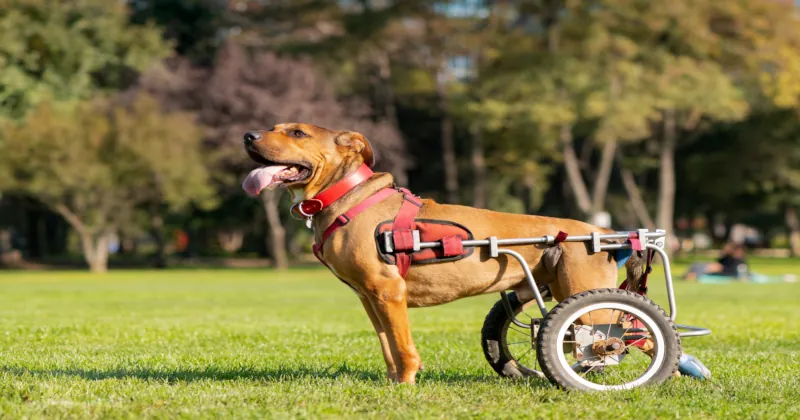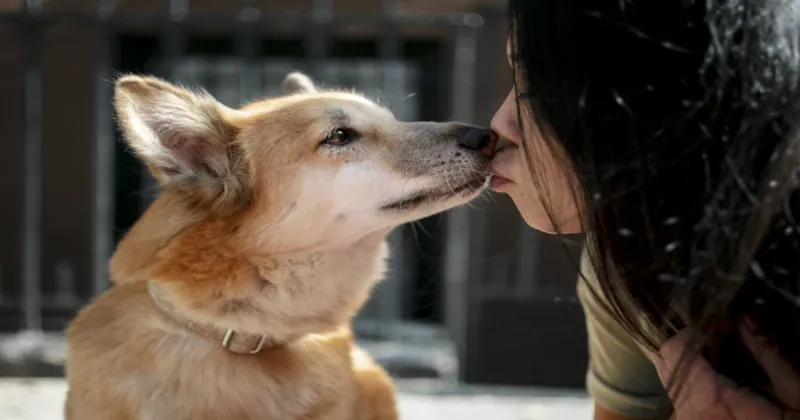Table of Contents
Why Every Minute Matters
Your dog suddenly drags a rear paw, sits and refuses to get back up, or wobbles as if the floor turned to ice. In that heart-stopping moment you’re probably asking, what causes sudden hind leg weakness in dogs and—more urgently—how fast do I need to act?
Here’s the hard truth: the spinal cord and major nerves that control your dog’s back legs have a narrow “golden hour.” In many cases—ruptured discs (IVDD), fibrocartilaginous embolism (FCE), or acute trauma—permanent nerve damage starts within 60–90 minutes. Quick intervention can mean the difference between a full recovery and lifelong disability.
Think of it like a stroke or heart attack in people: the sooner a veterinarian can relieve pressure, restore blood flow, or stabilize the spine, the higher the odds of success. Waiting “to see if it gets better overnight” often lets swelling or internal bleeding progress unchecked.
By moving fast you also give your vet a clear picture of early symptoms, which streamlines diagnostics and speeds up treatment options such as anti-inflammatory medication, surgery, or supportive care. Throughout this guide we’ll demystify what causes sudden hind leg weakness in dogs, outline the symptoms you should watch for, and walk you through simple exercises, stretches, and home-care steps that bring relief once the crisis has passed. For now, let’s make sure you can spot the danger signs that demand an immediate trip to the ER.
Red-Flag Symptoms Requiring the ER Tonight

Call your nearest 24-hour clinic right away if you notice any of these warning signs. Even if you’re still wondering what causes sudden hind leg weakness in dogs, treating these symptoms as an emergency can save precious nerve function.
🚨 Emergency Symptom | Why It’s Critical |
Complete collapse or inability to rise | Possible spinal fracture, disk extrusion, or vascular event |
Screaming, yelping, or sudden aggression when touched | Acute pain suggests severe nerve compression or fracture |
Loss of bladder or bowel control | Indicates spinal cord involvement at or above the sacral nerves |
Dragging toes / “knuckling” under | Early sign of neurologic deficit—minutes count |
Sudden hind-end paralysis after trauma (fall, hit-by-car) | Rapid swelling can permanently sever nerve signals |
Rapid breathing, pale gums, or weakness plus bloated abdomen | Could be internal bleeding or toxic shock |
Fever, rigid stance, or recent tick exposure | Tick paralysis or infectious meningitis needs prompt antitoxin or antibiotics |
If even one of these symptoms appears, do not wait for regular office hours. Gently slide a towel under your dog’s belly for support, keep the spine as straight as possible, and head to the emergency hospital. Swift action lets the vet start diagnostics—X-rays, bloodwork, or advanced imaging—and choose the right treatment options before irreversible damage sets in. Relief begins with rapid recognition.
Quick 5-Point Home Mobility Check
Before you jump to search engines asking what causes sudden hind leg weakness in dogs, do a calm, 60-second scan. These gentle checks won’t replace a vet visit, but they give priceless clues you can share during the call or on the ride over.
Step | How to do it | What you’re looking for |
1. Paw-Flip Test | While your dog is standing, bend one back paw so the top of the toes touch the floor. Let go. | A healthy dog instantly flips the paw back. A slow or absent correction hints at nerve trouble. |
2. Knuckling Walk | Have your dog take two or three steps on that flipped paw. | Dragging toes or scraping nails adds evidence of neurologic weakness. |
3. Tail-Tone Squeeze | Gently tug or squeeze the base of the tail. | A firm “clamp back” is normal. A floppy tail signals impaired spinal nerves. |
4. Toe-Pinch Reflex | Using your thumb and forefinger, pinch the skin between the back toes for one second. | A quick pull-back or head turn shows feeling; no reaction suggests deeper injury. |
5. Hopping Balance Test | Support your dog’s chest, lift one rear leg, and nudge him sideways. | A normal dog hops to regain balance. Collapsing or crossing legs means coordination loss. |
Safety tips:
Always keep the spine straight, avoid jerky stretches, and stop if pain makes your dog yelp. Log each result—good or bad—in your phone. When your veterinarian asks about symptoms, you’ll have concrete data, speeding up treatment options and, hopefully, relief.
Four Big Cause Buckets at a Glance

Knowing what causes sudden hind leg weakness in dogs starts with seeing the forest before the trees. Nearly every case drops into one of four broad categories:
1. Neurological
Compressed or damaged nerves—think intervertebral disc disease (IVDD), fibrocartilaginous embolism (a tiny spinal “stroke”), degenerative myelopathy, or direct spinal trauma. Symptoms often appear as knuckling, stumbling, or full paralysis.
2. Orthopedic
Muscle, joint, or bone disasters such as a torn ACL/CCL, hip luxation, patellar dislocation, or an unseen fracture. Pain is sharp, and your dog may refuse to bear weight but still has feeling in the paw.
3. Systemic & Metabolic
Internal conditions that sap strength—Addison’s crisis, heart failure, diabetic neuropathy, severe anemia, or tick-borne diseases like Lyme or Ehrlichia. Weakness may wax and wane, and other symptoms (vomiting, pale gums, fever) tag along.
4. Toxic & Environmental
Rapid collapses from snake bites, botulism, macadamia nut poisoning, heatstroke, or certain medications. Sudden onset plus vomiting, tremors, or excessive drooling often point here.
By slotting your dog’s symptoms into these buckets, you and your vet can zero in on the right diagnostics, exercises, or stretches for recovery. The next sections unpack each group in detail, guiding you toward the best treatment options for lasting relief.
Neurological Culprits Explained
Think of the spinal cord as a fiber-optic cable: when it’s pinched, bruised, or deprived of blood, messages to the back legs drop out instantly. Here are the five biggest nerve-center offenders and what they look like at home and in the clinic.
Condition | How it starts | Hallmark signs | Vet diagnostics & typical care |
Intervertebral Disk Disease (IVDD) | Gel inside a disk shoots outward and presses on the cord—common in Dachshunds, Frenchies, Beagles. | Yelping when picked up, “drunken” rear gait, sudden paralysis if the disk fully ruptures. | Neurologic exam → X-rays or CT/MRI. Emergency surgery or high-dose steroids plus crate rest. |
Fibrocartilaginous Embolism (FCE) | A tiny disk fragment blocks a spinal blood vessel—usually after zoomies or a jump. | Collapse on one side, little to no pain, rapid plateau in 24 h. | MRI confirms; no surgery needed. Intensive physiotherapy, underwater treadmill, passive stretches. |
Degenerative Myelopathy (DM) | Genetic demyelination (similar to ALS in people), most often in German Shepherds, Corgis, Boxers over age 7. | Slow knuckling, worn nails, then creeping weakness; rarely painful but can feel “sudden” after exertion. | DNA cheek swab, rule-out tests. No cure; focus on weight control, daily rehab, rear harness, laser therapy. |
Lumbosacral Stenosis (“Cauda Equina”) | Narrowing at the spine’s base compresses nerve roots—seen in older large breeds. | Difficulty jumping into cars, weak tail wag, hind-end pain that flares after exercise. | CT/MRI, electrodiagnostics. Options: anti-inflammatories, epidural steroids, sometimes decompression surgery. |
Acute Spinal Trauma | Falls, car accidents, or rough play fracture vertebrae. | Sudden scream, non-weight-bearing, possible incontinence. | Stabilize first! X-rays/CT, emergency surgery or external splints, strict cage rest. |
Key takeaway: Neurologic causes can be painless (FCE, DM) or agonizing (IVDD, trauma). Fast transport on a firm board or folded blanket keeps the spine straight, buying time until your vet can decompress swollen tissue and start targeted treatment options.
Orthopedic Catastrophes That Strike Fast

Not every rear-leg collapse involves the spinal cord. Sometimes the skeleton or its supporting soft tissues fail in a split second. These orthopedic hits are high on the list of causes, symptoms, and relief strategies you’ll discuss with your vet.
Injury | Common trigger | What you’ll see | Immediate first aid | Definitive treatment |
Cranial Cruciate Ligament (CCL) Tear | Sudden pivot during fetch, or slow fraying in heavier dogs. | Non-weight-bearing rear leg, knee feels loose (“drawer sign”). | Ice pack 10 min on, 20 min off; restrict movement. | TPLO or lateral suture surgery, then controlled leash walks and quad-strengthening exercises. |
Hip Luxation or Severe Dysplasia Flare | Car impact, slip on tile, or chronic laxity in large breeds. | Leg appears shortened, toe points inward, intense groaning if moved. | Towel sling; keep hips aligned. | Closed reduction under anesthesia or surgical toggle-pin / FHO; long-term joint supplements and weight management. |
Patellar (Knee-Cap) Dislocation | Jump down from couch—tiny breeds most at risk. | “Skip” step, quick yelp, then holding leg up; may pop in and out. | Gentle massage may slide it back, but see vet. | Medial release or groove-deepening surgery; at-home strengthening of quads and core. |
Acute Fracture | Falls, rough landings, being stepped on. | Obvious deformity, grinding bone noise, swelling. | Splint with rolled magazine and tape; keep dog calm. | Surgical plating or external fixator, followed by crate rest and passive range-of-motion stretches. |
How to tell bone vs. nerve at home
- Pain level – Most orthopedic injuries are very painful; neurologic events like FCE or DM are often oddly painless.
- Paw placement – Dragging or knuckling screams nerve; holding the leg aloft but keeping toes curled normally leans bone/joint.
Regardless, you’ll still share the same critical question with your vet—what causes sudden hind leg weakness in dogs—so a speedy, gentle trip to the clinic remains rule #1. The sooner the joint is stabilized or the ligament repaired, the quicker you can start tailored rehab exercises and restore an active, tail-wagging life.
Systemic & Metabolic Shockers
When a whole-body disorder starves the muscles or nerves of oxygen, sugar, or electrolytes, the back legs are often the first to give way. Below are the “silent saboteurs” every dog parent should know.
Condition | Why it strikes fast | Tell-tale clues at home | Vet tests & treatment options |
Addison’s Crisis (adrenal failure) | Stress drains already-low cortisol and electrolytes crash. | Sudden wobbliness, vomiting, weak pulse, shivering. | Electrolyte panel, ACTH stim test → IV fluids, steroid injection; long-term hormone tablets. |
Acute Heart Failure | Pump can’t push enough blood to rear muscles. | Heavy panting, blue-tinged gums, fainting spells. | Chest X-ray, ultrasound, BNP blood test → oxygen cage, diuretics, heart meds. |
Severe Anemia | Too few red cells to feed the legs. | Pale gums, rapid breathing, exercise intolerance, collapse. | CBC, clot tests → transfusion, iron/B-vitamins, fix bleeding source. |
Diabetic Neuropathy or Hypoglycemia | High sugar damages nerves; low sugar starves them. | Wobbly walk, glazed eyes, tremors, sweet breath or sudden lethargy. | Glucose curve, urinalysis → insulin tweak or dextrose drip; diet overhaul. |
Tick-Borne Diseases (Lyme, Ehrlichia) | Bacteria inflame joints and nerves. | Shifting-leg lameness, fever, swollen joints, loss of appetite. | SNAP 4Dx, PCR → doxycycline, anti-inflammatories, rest. |
Fast home check: Feel the gums. They should be bubble-gum pink and moist. White, blue, or brick-red gums scream “systemic emergency.” While you cradle your pup, call the vet and mention any recent tick bites, medication changes, or chronic illnesses. Treating the underlying disease—whether that’s a steroid boost, dextrose drip, blood transfusion, or heart med—often restores strength within hours to days, followed by gentle rehab exercises and a tailored nutrition plan.
Toxins & Environmental Hazards

A perfectly healthy dog can crumple in minutes if a venom, poison, or extreme temperature interrupts nerve signaling. If you live where snakes roam, keep macadamia nuts on the coffee table, or train outdoors in summer, keep this short list on your fridge.
Hazard | Time to symptoms | Classic signs | First aid at home | Veterinary care & relief |
Snake or Spider Venom | 10 min – 6 h | Sudden collapse, swelling, puncture marks, dark urine. | Keep dog calm, carry—don’t let him walk; photo the snake if safe. | Antivenom, pain relief, IV fluids, clotting tests. |
Macadamia Nut Toxicity | 3 – 12 h | Rear-leg tremors, vomiting, fever. | Call poison control; vet may induce vomiting if recent. | Activated charcoal, fluids, temperature control; most recover within 48 h. |
Botulism (spoiled meat or dead wildlife) | 12 – 72 h | Progressive weakness, drooling, mega-esophagus, breathing difficulty. | None at home—needs hospital care. | Antitoxin, feeding tube, ventilator support if needed. |
Ivermectin or Pesticide Overdose | 30 min – 24 h | Staggering, dilated pupils, seizures. | Do not induce vomiting unless vet says so. | IV lipid therapy, seizure control drugs, monitoring. |
Heatstroke Collapse | Minutes | Panting, brick-red gums, rapid hind-leg failure, collapse. | Move to shade, wet towels, offer small sips of cool (not icy) water. | IV fluids, cooling catheter, blood-clot monitoring; follow-up stretches once stable. |
Quick field checklist
- Seen or heard a rattle, hiss, or snap? Venom tops the list.
- Garbage raided or yard treated with chemicals? Think toxins.
- Temperature above 80 °F with high humidity? Heatstroke climbs the chart.
In all cases, bring any product label, nut package, or photo of the culprit to the clinic. Early antidotes or cooling measures often reverse weakness within hours. Once home, light leash walks, gentle stretches, and plenty of hydration speed full recovery.
With systemic diseases and environmental threats covered, you now have a clearer picture of the many paths leading to sudden rear-leg collapse. Next, we’ll show how veterinarians connect the dots through smart diagnostics—and how that roadmap guides the best treatment plan for lasting relief.
How Vets Pinpoint the Problem (Diagnostics 101)

By now you’ve learned that what causes sudden hind leg weakness in dogs spans nerves, bones, organs, and even snakebites. Your veterinarian’s job is to narrow those possibilities fast and start relief. Here’s the typical step-by-step, so nothing catches you off guard:
Stage | What happens | Why it matters | Ball-park cost* |
Hands-On Neuro & Ortho Exam | Reflex hammer taps, toe flips, joint palpation, spine “pain map.” | Separates nerve crises from bone or muscle injuries in minutes. | Included in consult ($75 – $150) |
Basic Blood & Urine Panel | Checks sugar, electrolytes, kidney/liver values, red-cell count. | Rules out Addison’s, anemia, diabetic swings, infections. | $120 – $250 |
X-Rays | Hips, knees, spine in two views. | Finds fractures, dislocations, disk spacing clues. | $150 – $300 |
Advanced Imaging (CT or MRI) | 3-D pictures of disks, spinal cord, soft tissue. | Gold standard for IVDD, FCE, tumors. | CT $800 – $1,200; MRI $1,500 – $2,500 |
CSF Tap / Electrodiagnostics | Collects spinal fluid; measures nerve conduction. | Confirms meningitis, immune disease, or exact nerve injury level. | $500 – $900 |
Tick & Toxin Screens | SNAP tests, clotting panels, toxicology. | Catches treatable culprits like Lyme or rodenticide. | $40 – $180 |
*Costs vary by region; ask for an estimate before each step.
Time line: A straightforward ortho injury can be diagnosed within an hour. Complex neurologic mysteries may need overnight imaging or referral to a specialty center. The more details you share—video of the collapse, that 5-point home check, diet history—the faster the vet can connect causes to symptoms and choose the safest treatment options.
Treatment Paths: From Meds to Surgery to Rehab
Think of recovery as a three-lane highway: medical management, surgical fix, and rehabilitation. Your dog may cruise one lane or merge between all three.
Medical Management
- Pain & anti-inflammatory meds: Carprofen, gabapentin, or steroids calm swelling so nerves can breathe.
- Muscle relaxers: Ease spasms that make every step hurt.
- Targeted drugs: Heart meds for cardiac weakness, insulin tweaks for diabetic neuropathy, doxycycline for tick disease.
Surgical Fix
Surgery | Best for | What to expect | Success outlook |
Hemilaminectomy / TPLO / FHO | Ruptured disks, torn CCL, hip luxation. | Overnight stay, 6–12 week rest, stitches out at 14 days. | 80-95 % dogs walk pain-free again. |
Spinal Fracture Plating | High-impact trauma. | May need ICU; strict crate for 8 weeks. | Good if deep pain is present pre-op. |
Decompression & Stenosis Surgery | Lumbosacral narrowing. | Shorter incision, often same-day release. | 70 % show stronger gait within a month. |
Rehabilitation & Mobility Aids
- Passive range-of-motion stretches: 10 reps, three times a day to prevent joint stiffness.
- Underwater treadmill or swim therapy: Buoyancy lets muscles work without weight.
- Rear-support harnesses, slings, or dog wheelchairs: Keep adventures going while nerves repair.
- Home environment tweaks: Non-slip mats, low-rise ramps, raised food bowls.
Timeline snapshot:
1–3 days → pain under control; 2 weeks → wound healed or meds fine-tuned; 6–12 weeks → muscle strength rebounds with guided exercises; lifetime → maintenance stretches, ideal weight, joint supplements for lasting relief.
Stay in touch with your veterinary team, celebrate small gains (those first toe wiggles!), and remember: most dogs regain happy, mobile lives when a well-planned treatment path is followed with patience and love.
Rehab at Home: 10 Vet-Approved Exercises & Set-Up Tips

Once your vet has answered what causes sudden hind leg weakness in dogs and the acute phase is over, rehab becomes the engine of recovery. Done right, these simple routines rebuild strength, prevent muscle wasting, and give your dog a confidence boost.
Rule of thumb: If any move causes yelping, shaking, or a sudden sit-down, stop and phone your vet. Progress should feel like “gentle effort,” never pain.
# | Exercise or Set-Up | How to Do It | Why It Helps |
1 | Passive Range-of-Motion (PROM) | With your dog lying on the good side, support the weak leg above and below the joint. Slowly flex and extend knee, hock, and toes 10×. | Keeps joints lubricated; prevents contractures. |
2 | Towel-Sling Walks | Slip a bath towel under the belly, hold each end like suitcase handles, and let your dog “walk” 10–15 steps. | Re-trains gait while off-loading weight from sore legs. |
3 | Weight-Shift Stand | While your dog stands, gently nudge the hip left and right—5 nudges each side. | Fires stabilizer muscles and core. |
4 | Cavaletti Poles | Lay broomsticks 6–8 in apart; have the dog step over them slowly. Start with 2 passes. | Encourages high paw lift; improves proprioception. |
5 | Sit-to-Stand Reps | On a non-slip mat, cue a sit, then a stand—5 reps, twice daily. | Strengthens quads and glutes—dog-sized squats. |
6 | Figure-8 Walks | Guide your dog around two cones or chairs in a tight figure 8. | Engages hip rotators and balance. |
7 | Low-Step Ups | Use a phone book or 4-in platform; lure front paws up, back down—6 reps. | Builds rear-end drive without jumping. |
8 | Hydrotherapy (Bath-Tub Marches) | In chest-deep lukewarm water, march your dog forward 5 ft and back. | Buoyancy reduces strain while adding gentle resistance. |
9 | Cookie-Stretch Bends | Hold a treat near the hip or shoulder so your dog bends to reach it—3 bends per side. | Improves spine flexibility and core strength. |
10 | Paw-Target Touches | Stick a Post-it on the floor; cue your dog to tap it with the weak paw—10 taps. | Sharpens limb awareness and coordination. |
Home-Gym Set-Up Tips
- Non-Slip Flooring: Yoga mats or rubber runners prevent splits and slides.
- Adjustable Traction Socks: Great for slick wood floors; remove after sessions to keep nails healthy.
- Low-Rise Ramps: Replace stairs to couches or cars, easing pressure on healing joints and nerves.
- Timed Sessions: Two short workouts (10–15 min) beat one long slog—muscles need breaks to rebuild.
- Progress Journal: Note reps, wobble level, and any setbacks. Sharing this log helps your vet fine-tune treatment options for lasting relief.
Choosing & Using Mobility Aids

Even the best rehab plan benefits from the right gear. The market is crowded, so here’s an easy roadmap to match aid to need—without wasting cash or causing new aches.
Aid | Best For | Sizing Tip | Training Hack |
Rear-Support Harness | Dogs who can bear some weight but stumble. | Measure girth in front of hind legs; straps should slide two fingers under comfortably. | Start with 5-min strolls to pair harness with positive walks. |
Full-Body Sling | Post-surgery pups or those with very weak cores. | Chest and belly pads must not pinch elbows or ribs. | Practice lifting for a second, then reward—build trust before stairs. |
Dog Wheelchair (Rear Cart) | Paralysis or no deep-pain sensation. | Match weight and hip height; wheels level with hip joint. | Begin on grass for controlled speed; use treats to encourage forward drive. |
Booties / Traction Socks | Tile or hardwood slip-n-slides. | Trace paw on paper and measure longest length; boot should fit snug. | Short indoor sessions first—many dogs “high-step” until they adjust. |
Orthotic Braces (knee, hock) | Partial ligament tears, joint laxity. | Custom casts yield best fit; off-the-shelf models need foam shims for gaps. | Combine brace wear with sit-to-stand reps to build supportive muscles. |
Quick-Pick Buying Checklist
- Lightweight frame: Aluminum beats steel for wheelchairs—less drag, more stamina.
- Easy-clean fabrics: Look for neoprene or machine-wash liners to prevent skin sores.
- Adjustability: Growth-spurt puppies and senior muscle loss both demand multiple strap holes.
- Return policy: Aim for at least 30 days; swapping sizes is common.
Pro Tip: Bring your chosen aid to the next rehab session. Your vet or canine-physio can confirm fit, teach safe transfers, and add stretching cues that sync perfectly with the device.
With smart exercises and well-fitted equipment, most dogs regain the freedom to stroll, sniff, and chase leaves. Up next: how to fuel that comeback with the right foods and supplements.
Feeding for Recovery

Food is more than fuel—it’s your dog’s daily medicine. The right bowl can shorten healing time and keep future flare-ups at bay. Here’s how to build a recovery plate:
Protein With Purpose
Muscles worn down by injury crave high-quality protein. Aim for 25–30 % of calories from lean meats such as turkey, chicken, or sustainably-fished salmon. Protein supplies the amino acids that repair torn fibers and rebuild nerve sheaths.
Anti-Inflammatory Fats
Omega-3s (EPA/DHA) act like natural ibuprofen, taming the swelling that often follows orthopedic surgery or nerve trauma. Choose a fish-oil capsule delivering about 100 mg EPA + 60 mg DHA per 10 lb of body weight. Plant sources like flax work in a pinch but convert poorly in dogs.
Joint-Smart Supplements
- Glucosamine & Chondroitin: Cushion joints and slow cartilage loss.
- MSM (methylsulfonylmethane): Reduces soreness, aids collagen synthesis.
- Green-lipped mussel or collagen peptides: Bonus glycosaminoglycans for ligaments.
Look for veterinary-formulated blends; human tablets often contain xylitol or too much manganese.
Weight-Watch Portion Guide
Extra pounds pile stress on healing knees, hips, and spines—common causes behind sudden hind-leg weakness. Use the ribs test: you should feel, not see, each rib with a light swipe of your fingers. If a layer of padding hides them, cut portions by 10 % and swap high-calorie treats for carrot coins.
Target Weight (lb) | Daily Calories for Recovery* |
10 | 260–300 |
25 | 550–650 |
50 | 900–1 050 |
75 | 1 200–1 400 |
*For dogs on crate rest or gentle rehab. Active adults need more.
Hydration & Micronutrients
Dehydrated nerves fire slower. Keep fresh water within nose range—especially if pain meds increase thirst. Add a teaspoon of unsalted bone broth to entice picky drinkers and deliver extra minerals like calcium and phosphorus.
Tip: Split meals into 3–4 mini-servings. Smaller, frequent feedings stabilize blood sugar and prevent the heavy-belly slump that can stress weak rear legs.
Prevention by Life Stage
Knowing what causes sudden hind leg weakness in dogs is step one; step two is stacking the deck so it never happens—or never happens again. Prevention looks different for a wiggly pup versus a silver-muzzled senior, so let’s break it down.
Puppy Power (0–12 months)
- Hip & Patella Screening: Ask your vet about early hip palpation and baseline knee exams—critical for breeds like Labs, Goldens, and Frenchie puppies.
- Controlled Growth: Large-breed formulas balance calcium and phosphorus, lowering the odds of rapid-growth joint deformities.
- Safe Play Surfaces: Rubber mats or grass minimize skid-outs that can twist fragile cruciate ligaments.
Prime Adult Maintenance (1–7 years)
- Balanced Conditioning: Mix distance walks with short hill climbs or figure-8 drills to build rear-end strength without over-working joints.
- Monthly Preventives: Year-round tick and heartworm meds guard against infectious culprits such as Lyme or ehrlichiosis—hidden causes of leg weakness.
- Core-Strength Routines: Add sit-to-stand sets and gentle cavaletti poles twice a week; strong cores stabilize the spine during rough-and-tumble play.
Senior Safeguards (7 + years)
Risk Factor | What to Watch | Prevention Move |
Degenerative Myelopathy (GSD, Pembroke Corgi, Boxer) | Knuckling, worn rear nails | DNA test at annual exam; start daily proprioception drills early. |
Arthritis & CCL Tears (Lab, Golden, Rottie) | Stiff rise after naps | Keep body-condition score 4/9; consider monthly pentosan or joint injections. |
Lumbosacral Stenosis (large mixes) | Reluctance to jump into car | Install low-angle ramps, begin underwater treadmill sessions for spinal support. |
Additional senior tips:
- Orthopedic Beds: Memory-foam mattresses reduce pressure on bony hips.
- Quarterly Weight Checks: Even a 5-lb gain magnifies joint stress in medium dogs.
- Semi-Annual Bloodwork: Early catches on diabetes, kidney disease, or anemia prevent muscle-sapping metabolic crises.
With preventive know-how for every life stage and a recovery diet dialed in, you’re well on your way to shielding your companion from most pathways that trigger sudden rear-leg collapse. Up next: fast answers to the questions dog parents ask most and a curated hub of support resources, so you’re never alone in this journey to lasting relief.
Helpful Support & Resource Hub
- Canine Rehabilitation Institute – Find a Certified Therapist
Searchable map of credentialed rehab vets and physical therapists who can craft exercise and stretch plans. - Walkin’ Pets Equipment Guides
Sizing charts, video fittings, and customer support for wheelchairs, slings, and traction aids. - Dodgerslist IVDD Community
24/7 forum where owners swap recovery tips, crate-rest schedules, and proven pain-med protocols. - FACE Foundation & RedRover Relief
Non-profit grants that help cover emergency surgery or imaging when sudden bills hit hard. - Ticks & Pets Hotline (1-855-TICKHELP)
Free advice on tick removal and signs of toxin-linked hind-leg weakness. - Facebook Groups
“Degenerative Myelopathy Support” and “FCE Dog Survivors”—peer-run spaces for sharing rehab wins, harness hacks, and emotional backup. - American College of Veterinary Surgeons (ACVS) Client Guides
Plain-English explainer sheets on TPLO, hemilaminectomy, and fracture repair—perfect for understanding treatment options after your vet appointment.
Bookmark these links or keep them in your phone. When you’re tired, worried, and searching what causes sudden hind leg weakness in dogs at 3 a.m., a live community or clear hand-out can calm the panic and point you—and your pup—toward lasting relief.
Read more –
Best Home Remedies for Dog Scooting That Actually Work
Why Is My Dog Panting at Night? A Warning for Dog Lovers
FAQs
Why did my dog go from running to dragging a back leg in seconds?
The most common answer to what causes sudden hind leg weakness in dogs is a burst disk (IVDD) or torn cruciate ligament. Both strikes fast and need same-day vet help.
Can a dog recover full use of paralyzed back legs?
Yes—if deep pain is still present and care starts within the first 24 hours. Surgery for IVDD or a strict rehab plan for FCE often brings dogs back to normal walks.
Is sudden weakness always painful?
No. Vascular events like FCE and degenerative myelopathy are usually painless, while fractures or disk ruptures hurt badly. Pain level is one clue your vet uses to sort the causes.
Do joint supplements replace surgery?
They ease arthritis and speed healing, but they can’t knit a torn ligament or lift pressure off the spinal cord. Think “supporting actor,” not “main star.”
How long before I see improvement?
Mild nerve bruises may show toe-wiggles within 72 hours. Surgical recoveries often need 6–12 weeks of crate rest plus exercises. Chronic diseases like DM progress slowly despite therapy.
Should I massage or stretch my dog on day one?
Wait for your vet’s green light. Early gentle PROM is helpful for many injuries, but certain fractures or fresh incisions must rest first.
What flooring is best for weak hind legs?
Rubber runners or interlocking foam tiles give traction without tripping edges. Avoid throw rugs that slide.
Can ticks really paralyze a dog?
Yes. Neurotoxins from some ticks block nerve signals, causing rear-leg collapse. Removal plus anti-toxin meds usually reverse signs in 24–48 hours.
Will my dog’s hind-leg weakness spread to the front legs?
Only in conditions that climb the spinal cord (advanced IVDD, tumors, some toxins). Rapid reevaluation is vital if front-leg wobble appears.
How do I lift a 70-lb dog safely?
Thread a wide bath towel under the belly like a sling, keep the spine straight, and lift with your knees—not your back. A rear-support harness is even safer for daily use.


